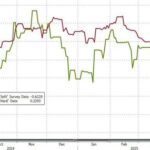
Navigating the Downturn: Nvidia, ASML, and AMD Confront Stock Challenges
Tháng 4 16, 2025
Jerome Powell’s Economic Outlook: Navigating Inflation and Trade Policies in 2025
Tháng 4 16, 2025Insights on Jerome Powell’s Anticipated Speech and Its Economic Implications
Jerome Powell, the Chair of the Federal Reserve, is expected to deliver a highly scrutinized speech at the Economic Club of Chicago on April 16, 2025. This event marks a pivotal moment for investors and economists alike, as Powell’s insights on the economic outlook, interest rates, and inflation are eagerly awaited. In a climate where economic conditions are in constant flux, the implications of Powell’s remarks could resonate far beyond the immediate market adjustments.
Market Expectations and Investor Sentiment
As Powell takes the stage, investor focus will be on his comments regarding key economic indicators such as inflation, tariffs, and the job market. His speech comes on the heels of a noteworthy trend in U.S. consumer price index (CPI) data, which has recently shown signs of decline. This shift in CPI could indicate potential flexibility in the Federal Reserve’s approach to interest rates, igniting discussions about the possibility of rate cuts as early as May. However, the exact timing of any adjustments remains uncertain, and market participants are on high alert for signals from Powell that could shape their strategies.
Interest rates serve as a fundamental driver for economic activity, influencing everything from consumer spending to business investments. Should Powell hint at a dovish stance, it may bolster market confidence, providing a surge in stock prices and easing concerns about an economic slowdown. Conversely, a hawkish tone could instigate volatility, as investors recalibrate their expectations and prepare for a tighter monetary policy environment. For a deeper understanding of investment strategies during such times, you can explore 3 Reasons Greenblatt Says Value Investing Beats the Market here.
The Economic Context: Retail Sales and Tariff Implications
The backdrop to Powell’s anticipated remarks is defined by a mixture of optimism and concern within the U.S. economy. The reported 1.4% increase in U.S. retail sales for March provides a glimpse of resilience, particularly driven by the purchase of major commodities, such as vehicles. It’s plausible that consumers are making purchases now in anticipation of inflationary effects stemming from tariffs, which have contributed to heightened market anxiety.
The ongoing trade tensions, particularly the imposition of tariffs on various imports, have not only fostered uncertainty in the marketplace but have also led to degradation in consumer confidence. With sentiment declining for four consecutive months, consumer anxiety surrounding rising prices and potential job cuts is palpable. Powell’s address may address these tariff-related developments, shedding light on how the Fed intends to navigate these turbulent waters as part of their broader policy framework. For those considering how to navigate current market challenges, check out the Top Investment Mistakes to Avoid in 2023 here.
Moreover, the intricacies of the tariff situation, including retaliatory measures from countries like China, continue to complicate the landscape of global trade. As Powell discusses these issues, stakeholders will be keenly analyzing how such factors could influence the Federal Reserve’s monetary policy trajectory. As discussed in another insightful piece, Three Strategic Moves by China Xi, understanding the broader economic context can provide valuable insights here.
In conclusion, as Jerome Powell prepares to address the Economic Club of Chicago, the financial world will be watching closely. His insights into inflation, interest rates, and ongoing tariff implications will not only impact market movements in the immediate term but could also set the tone for the U.S. economy’s direction in the months to come. Stakeholders must stay alert, as the dynamics outlined in Powell’s speech could have lasting ramifications across sectors.
